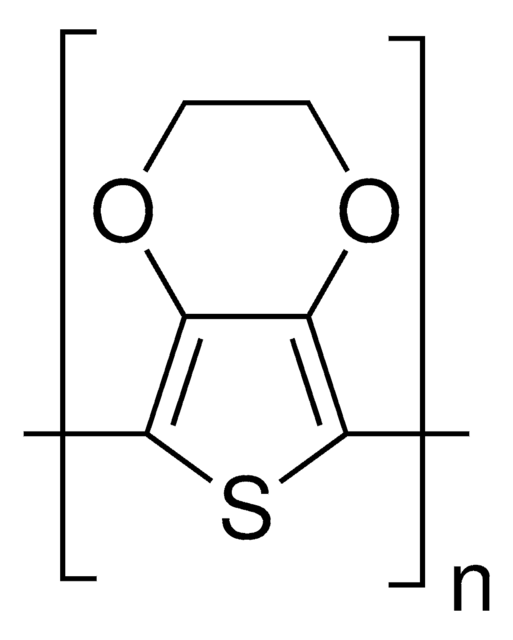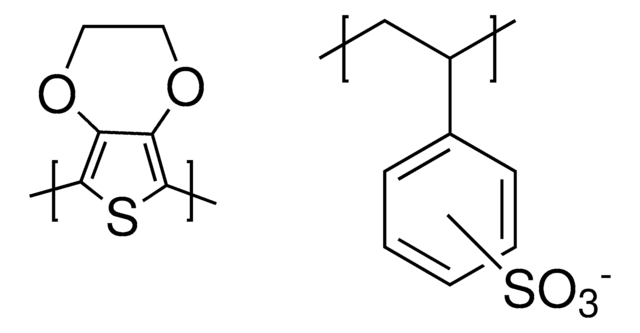推荐产品
产品名称
聚乙撑二氧噻吩-聚 苯乙烯磺酸盐, 3.0-4.0% in H2O, high-conductivity grade
等级
high-conductivity grade
质量水平
环保替代产品特性
Design for Energy Efficiency
Learn more about the Principles of Green Chemistry.
sustainability
Greener Alternative Product
浓度
3.0-4.0% in H2O
电阻
1500 Ω/sq, 4 point probe measurement of dried coating based on initial 6μm wet thickness.
500 Ω/sq, 4 point probe measurement of dried coating based on initial 18μm wet thickness.
pH值(酸碱度)
1.5-2.5 (25 °C, dried coatings)
电导率
>200 S/cm
粘度
10-30 cP(20 °C)
密度
1.011 g/cm3 (dried coatings)
环保替代产品分类
储存温度
2-8°C
正在寻找类似产品? 访问 产品对比指南
一般描述
应用
包装
警示用语:
Danger
危险声明
危险分类
Eye Dam. 1 - Skin Corr. 1
储存分类代码
8B - Non-combustible corrosive hazardous materials
WGK
WGK 3
闪点(°F)
Not applicable
闪点(°C)
Not applicable
个人防护装备
Faceshields, Gloves, Goggles, type ABEK (EN14387) respirator filter
法规信息
Which document(s) contains shelf-life or expiration date information for a given product?
If available for a given product, the recommended re-test date or the expiration date can be found on the Certificate of Analysis.
How do I get lot-specific information or a Certificate of Analysis?
The lot specific COA document can be found by entering the lot number above under the "Documents" section.
What is the ratio of PEDOT to PSS in Product 655201?
According to our supplier, the ratio of PEDOT to PSS is proprierary information.
How should Product 655201, PEDOT/PSS, be stored?
We recommend that you store this product at 2-8°C, which is in accordance with our MSDS.
What is the miniumum conductivity for Product 655201, PEDOT/PSS?
The minimum conductivity is 150 S/cm.
How do I find price and availability?
There are several ways to find pricing and availability for our products. Once you log onto our website, you will find the price and availability displayed on the product detail page. You can contact any of our Customer Sales and Service offices to receive a quote. USA customers: 1-800-325-3010 or view local office numbers.
What is the Department of Transportation shipping information for this product?
Transportation information can be found in Section 14 of the product's (M)SDS.To access the shipping information for this material, use the link on the product detail page for the product.
Is this PEDOT:PSS, poly(3,4-ethylenedioxythiophene)-poly(styrenesulfonate), product p-doped or n-doped?
This PEDOT:PSS product is based on hole-doped or P-type polymers. PEDOT can be n-doped, but the materials are too unstable to be of any commercial value.
For product 655201, Poly(3,4-ethylenedioxythiophene)-poly(styrenesulfonate), what is the relationship between film thickness and spin coating speed?
Please consult this graph showing the spin coating curve for product 655201, Poly(3,4-ethylenedioxythiophene)-poly(styrenesulfonate).
What is the temperature stability of this poly(3,4-ethylenedioxythiophene)-poly(styrenesulfonate), PEDOT:PSS, product?
Deposited poly(3,4-ethylenedioxythiophene)-poly(styrenesulfonate), PEDOT:PSS, films can easily withstand temperatures in excess of 200°C for short duration and around 70°C in continuous service. The aqueous dispersions of PEDOT:PSS, however, can be damaged by heating above 50°C for a prolonged period.
How do I test the coductivity of poly(3,4-ethylenedioxythiophene)-poly(styrenesulfonate), PEDOT:PSS?
Conductivity measurements should be performed on poly(3,4-ethylenedioxythiophene)-poly(styrenesulfonate), PEDOT/PSS, films deposited on flat substrates. This dispersion should be deposited as a thin and homogeneous layer on a flat substrate using deposition techniques, such as spin-coating or doctor blading. The layer thickness can be determined by scratching the film off the substrate in places with a razor blade and scanning the stylus of a mechanical or optical profilometer across the scratched region(s). The sheet resistivity can then be measured with conventional four-point probes.
Can PEDOT:PSS, Poly(3,4-ethylenedioxythiophene)-poly(styrenesulfonate), coatings be etched?
Yes, applied PEDOT:PSS films can be patterned by laser ablation.
My question is not addressed here, how can I contact Technical Service for assistance?
Ask a Scientist here.
商品
In the field of organic printable electronics, such as OLEDs and organic photovoltaics (OPVs), improved organic conducting and semiconducting materials are needed. The progress in two fields is reviewed in this article.
Conducting polymers such as polyaniline, polythiophene and polyfluorenes are now much in the spotlight for their applications in organic electronics and optoelectronics.
Advancements in bioelectronics, incorporating self-healing materials for wearable devices, and measuring bioelectric signals to assess physiological parameters.
Progress in Organic Thermoelectric Materials & Devices including high ZT values of >0.2 at room temperature by p-type (PEDOT:PSS) & n-type (Poly[Kx(Ni-ett)]) materials are discussed.
我们的科学家团队拥有各种研究领域经验,包括生命科学、材料科学、化学合成、色谱、分析及许多其他领域.
联系技术服务部门


